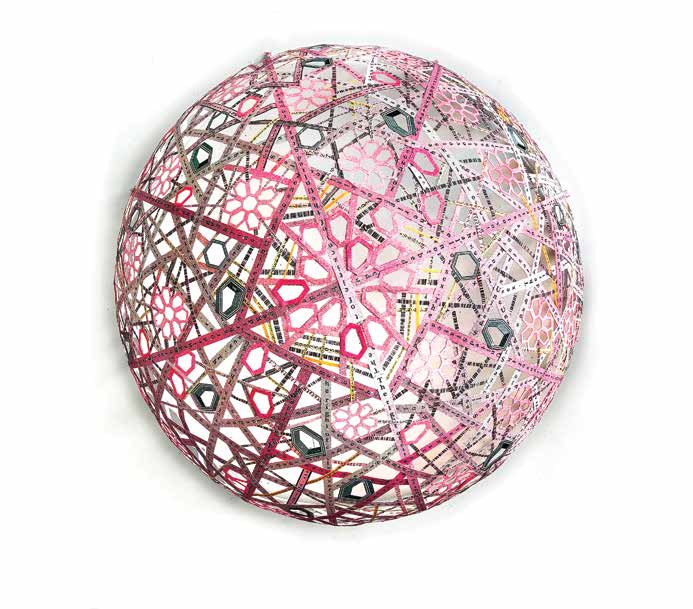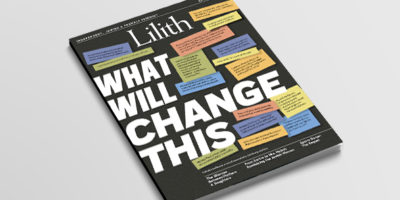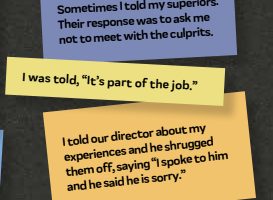
Donor Sperm: The Sequel
When, at 13, she meets half-siblings…

“19th Amendment” (by Nancy Baker, nancysbaker.com)
I have always known the truth about being conceived from donor sperm. The idea of meeting my half-brothers and half-sisters had always wandered around in the back of my imagination. It seemed unrealistic, like it would happen in a far-away universe. I daydreamed about walking down a New York City street on a brisk fall day and passing a face similar to mine. I imagined somehow knowing that I shared half the dna behind that face. I even thought about the happily-ever-after connection between the two of us.
Out of all the men who apply to be sperm donors, only 5 to 10% qualify. There are 14 major sperm banks in the United States, and the application process is extensive for all of them. Donors must be free of stis and hiv and under the age of 40. Prospective donors must pro-vide three generations’ worth of family medical history, and some sperm banks also require genetic testing. If men make it past the rigorous application and into the sperm donation program, they are required to make donations once a week for about a year. Sperm donors get paid only when their sperm count meets a certain threshold, so they have to watch their alcohol intake, how much sleep they get, and what food they put into their bodies. Because of this extensive and selective process, who would want to do it? Most donors are college students looking for extra cash. A small percentage are men in their thirties, some with families, who feel like helping people. If they personally know some-one with infertility, sperm donation may be a way of giving back.
I heard about the Donor Sibling Registry (dsr) from a friend in the same predicament: both of us had lesbian moms who had used donor sperm in order to conceive. About a year before, my friend had managed to find and meet her half-siblings on the dsr, an online database and center for families who used donor sperm. The prospect of finding people half-related to me was no longer restricted to my imagination.
Later that afternoon, my mom and I sat parked on the rug in my room. I gazed at the computer screen before us, all set up to register on the site. Anticipation built inside me. I stared blankly at the computer screen as my mom typed away. Last and first name. Sperm bank used. Donor number. Type of membership wanted on the Donor Sibling Registry. I reminded myself to take the next breath.
Throughout most of its history, sperm donation has been shrouded in secrecy. When donor insemination first started, it was used only for hetero-sexual couples in which the male was infertile. Sperm donation was pushed into the shadows because male infertility was seen as a disgrace.
As sperm donation became more widely used, doctors failed to keep adequate records that linked donors to recipients. While secrecy is no longer the norm, many sperm banks still fail to keep sufficient records. In an article published in the journal Politics and the Life Sciences, Barbara Raboy speaks on behalf of the Sperm Bank of California: “When we opened in 1982, some of our clients asked us to develop a way for donors to be identified by the offspring.
At the time, this idea was unheard of and was not offered by any sperm bank or physician in the United States.” In 1983, the Sperm Bank of California established its donor identity-release policy. This allowed donors to choose if they wanted to be identified when their offspring reached the age of 18.
Later that night, less than 24 hours after emailing the list of names that came up under donor #448 of the Pacific Reproductive Services, two alerts popped into my mom’s inbox, flipping my stomach—messages from two of my half-siblings.
Within hours, I was talking with my newly discovered sister, Gracie. What was I supposed to say to this girl whom I knew as little about as college calculus, but who shared half of my genetic code? Our conversation involved questions like “What do you do in your free time?” and “What’s your favorite color?” Pastimes and favorite colors were trivial, but neither of us knew how to interact at first. The deeper questions took almost two years to come.
Back when donor insemination first started, the term “sperm donor” was nonexistent. If a doctor was helping an infertile heterosexual couple become pregnant, the doctor would ask a healthy medical student, quietly, to donate. It was out of the question for the couple to request sperm from a specific person. Between the first use of donor insemi-nation in 1790 and the start of freezing sperm in 1953, the practice was kept hush-hush. As sperm freezing evolved throughout the 1950s and 1960s, the sperm bank industry expanded, especially in the United States. The clientele dominating the sperm consumer market shifted from heterosexual couples to single women and lesbians, and the issue of choice shifted as well.
Some argue that having the right to choose a donor means that the child will be less valued if he or she is not born with the characteristics desired by the parents. A strong moral principle in our society is that parents should accept their children the way they are. “Some commercial sperm banks, in their advertising, emphasize the idea that choosing the donor equals choosing the characteristics of the future child,” said an article In the journal Human Reproduction. On the other side, people argue for the right to choose a donor because it gives the woman or couple more control over the process. The article in Human Reproduction continued, “A person should have the right to make his/her own decisions. Choosing one’s donor, like choosing one’s partner, can be considered as one of those decisions.”
As I began to discover more of my siblings, my heart grew to include them. I scoured their Instagrams and stared at their pictures. None of them looked like replicas of me or of each other, but here and there I found that we shared the same eyes or the same cheekbones.Maybe a month after joining the dsr, a new question arose between my moms and me. How many people had been conceived with donor #448’s sperm? How many half-siblings were there? One mom kept a running list of every #448 family that had contacted her, but that’s all we had. Parents are not required to report a birth using donor sperm, so there is no accurate count of how many children have been conceived from mine or anyone else’s donor. Another mom in the #448 gang told us she had heard from the sperm bank that there were anywhere from 30 to 50 of us. Even if that wasn’t true, and those numbers were exaggerated, I had feelings I couldn’t identify. Maybe bewilderment, maybe wonder, maybe even terror.
Even if banks set a limit on how many families are allowed to conceive using a donor’s sperm, they depend on families reporting successful births to the bank, which does not always happen. National regulations focus much more on the quality of the sperm rather than how much is donated. Officials report an estimated 30,000 to 60,000 births each year that come from donated sperm.
One of the #448 moms, we found out, was organizing a meetup. Right around the time we first joined the dsr, she happened to be in the midst of planning it. “Do you want to go?” my mom asked. Of course I wanted to go and meet these people. Of course I wanted to talk to them and get to know them.
To date, more than 13,102 half-sib-lings have found each other through the dsr. In an online research study, donor-conceived children were asked about their reasons for searching for donor siblings. The two main responses were: “curiosity about appearance and personality” and “to know and understand a missing part of me.” The study showed that donor offspring made connections with their siblings that were generally positive. Most of the offspring who chose to search for their siblings were open about it with parents, friends, and family. When I searched for my siblings, I did not feel self-conscious or embarrassed. I felt joyous that I had found them, and I wanted to share that joy.
We decided to gather in Boston, with a couple of families living there, a couple of families driving up from Maryland, and a couple of families driving down from Vermont. The car ride was long, sweaty, and filled with antici-pation. My moms read aloud to each other while I listened to music. After parking the car and hauling our belongings into a friend’s house, there was not much time to get ready before joining everyone. I faced a dilemma. It was the end of summer and 80 degrees outside. Should I wear shorts? Should I put makeup on? What were the other girls going to wear? “We need to go in five minutes,” one of my moms yelled. I pulled myself together, jammed flip-flops on my feet and hurtled down the stairs.
As I settled into the back seat, I noticed the directions were printed on a piece of scrap paper, lying on my mom’s lap. With my low tolerance for lateness, and only 10 minutes to get there, a ner-vous sheen of sweat coated my palms.
Most of us were Jewish only children with lesbian parents. We were connected by this choice our parents had made: a selection between this vial of sperm or that one.
Twenty minutes later, after getting different directions, the actual address, and a helpful phone call from one of the #448 parents, we pulled into a grav-el driveway. We were hesitant to open the car doors, until a friendly looking woman came out to greet us. “I’m so glad you finally made it. Come on inside, everyone’s already here,” she said.
The parents were scattered in small clusters around the house, but all of the half-siblings were seated in the living room. The feeling was like entering the cafeteria on the first day of school. Meeting them one at a time was hard enough, but since I was the last to arrive, I was faced with six half-siblings all staring at me. It took me a moment to realize that they were smiling and welcoming me in, introducing themselves, and making room for me on the couch. Their faces were a blur. Manners held me back from staring at them, but I jumped on every chance I had to sneak in glances.
I don’t remember what we all talked about gathered in that living room—maybe what activities we enjoyed, maybe what we were going to be doing later. There was a surreal feeling to that living room. It came from the doorway, the cerulean wall paint, the two plush chairs, and the one large couch. It came from the nervous tapping of shoes on the floor and the thick buzz of the ceiling fan. It came from the teeth peeking out from under our smiles and the polite laughter leaking from our throats. Thankfully, it wasn’t long before the parents decided it was time to start the evening. Piling into various cars, we made our way over to a picnic below a sky striped with fireworks.
The families sprawled over blankets, chatting with one another as the last few finished up their meals. I don’t know which sibling was first to document the time on Snapchat, but soon we found a bit of the wall dividing us crumble as we exchanged usernames, gathering friends and followers. I sank into the toasty air, comforted by the glowing eyes around me, and watched the fireworks explode.
Later that night, we stopped at a massive ice cream parlor filled with chatter and life. What was I supposed to order? I didn’t want to order a double sundae and look greedy. I didn’t want to order vanilla in a dish and look boring. I didn’t want to order some made-up flavor decked with candy and nuts and look…weird. Eventually, settling down with our various orders, we began to laugh, a laughter different from our earlier giggles. Most of us were Jewish only children with lesbian parents. We understood each other’s families; we got each other’s jokes. Even though we had completely typical school lives, none of us had lives at home that matched the ones of our friends with “normal” families. We were connected by this choice our parents had made: a selection between this vial of sperm or that one.
Our laughter didn’t quit until the parents starting saying, “It’s late, and we should call it a night.” Even then, we lin-gered outside the ice cream parlor, still teasing and talking, feeling lucky to have each other. I was no longer trying to impress them, no longer worried about what I was wearing, saying or eating.
I assume one day I’ll meet my donor dad. It, too, seems like a remote scenario playing out in the back corner of my brain. There was once a time when I yearned to have a dad. I felt like there was a hole needing to be filled. Meeting my siblings filled that hole in a way I didn’t expect. For 13 years I had been an only child; now, I am part of a clan.
Sasha Hochman is a junior at Central High School in Philadelphia, PA. She is on the editorial board of jGirls Magazine and loves going to jazz concerts and philosophically ana-lyzing the covers of The New Yorker. This article originally appeared in jGirls Magazine.



